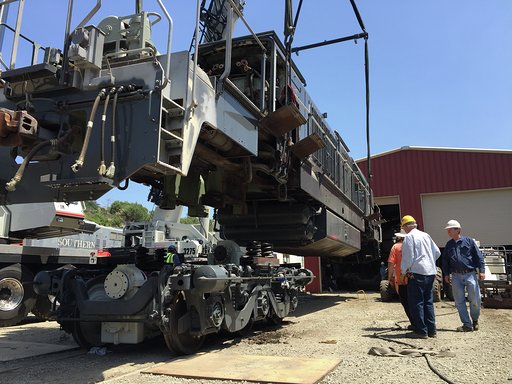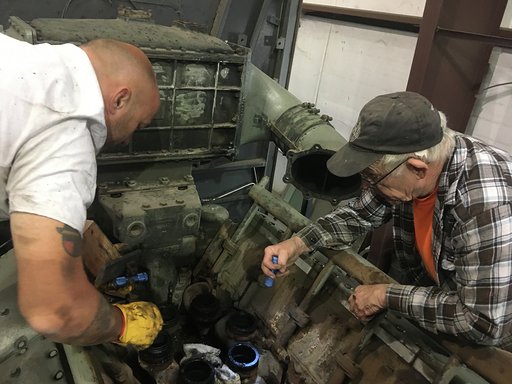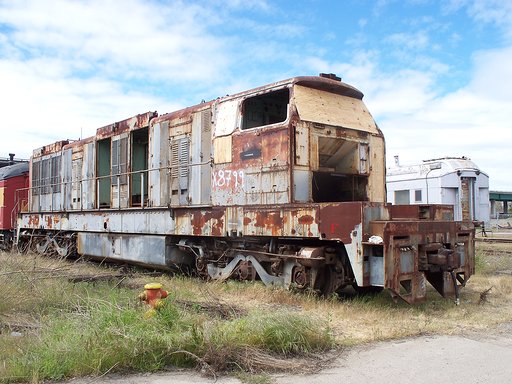The association’s restoration work on No. 9010, the last survivor of 37 German-built Krauss-Maffei ML 4000 C’C’ diesel-hydraulic locomotives in the United States and Brazil, is nearing completion, and will be mostly finished when the locomotive makes its official inaugural runs July 20-21.
These first runs, following an 11-year restoration effort, will be part of a series of celebrations of the 150th anniversary of the driving of the Golden Spike in Utah, marking formal completion of the Transcontinental Railroad. The Niles Canyon Railway operates a 10-mile segment of the original transcontinental line linking Sacramento to the Bay area.
At 3,540 h.p. at the rail, the Krauss Maffei diesel hydraulics — each with two 16-cylinder Maybach Mercedes-Benz MD 870 diesel power plants — provided more heft than conventional diesel locomotives from American builders could offer in the early 1960s in the midst of U.S. railroading’s horsepower wars. Three carbody units and 15 road-switcher versions were bought new by SP; Denver and Rio Grande Western bought three carbody versions, which were later sold to SP.
Unlike typical diesel locomotives that use generators and electric motors to transmit power from the prime mover to the wheels, diesel hydraulics like SP 9010 have “automatic” transmissions, universal drive shafts, and geared axles.
No. 9010 was delivered in Spring 1964. It and the other KMs were regulars on what No. 9010 PLA volunteer Robert Zenk called “the triangle,” operating between maintenance bases in Bayshore (near San Francisco), Roseville (near Sacramento), and turnarounds at Fresno or Bakersfield in the San Joaquin Valley. During their early years of operation, the KMs regularly traversed the Lathrop-Tracy-Niles line over Altamont Pass; the Niles Canyon Railway’s trackage is part of that latter route.
When successful higher-horsepower diesels were introduced by American builders in the mid-60s, the KM’s days were numbered. All of SP’s units, both the carbodies and road-switchers, were removed from regular service in 1968, but No. 9010 (already renumbered by then to No. 9113) was kept for use as a “camera car” to make films used in locomotive simulators for training locomotive crews. Zenk said that the structure of No. 9113’s nose, plus the ability to use part of the front engine compartment to store camera equipment, made the K-M a good candidate for this work. It was reconfigured, and renumbered No. 8799.
The unit was retired from camera car service in 1984, and donated to the California State Railroad Museum in 1986. It languished for several years before PLA acquired it in 2008. Restoration work started the next year, under the direction of PLA volunteer Howard P. Wise.
Zenk said several members of the organization were in Sacramento looking at pieces being de-accessed by the museum when they ran across No. 8799, “a cabless, doorless rusted hulk,” Zenk said. A young PLA volunteer on this trip was first to recognize this hulk’s importance.
“He said, ‘This is a very significant piece of American railroad mechanical history — we’ve got to save this,’” Zenk related. That it operated during its service life over what is now the PLA’s Niles Canyon Railway made the acquisition that much more relevant, Zenk said.
The rear engine needed a thorough cleaning, and a fair amount of ancillary work, including new fueling and cooling systems and radiators and new driveshafts. But Zenk said it was surprisingly straightforward to get the engine to turn over, given it had been idle since 1968, which meant its restoration would be possible and practical. That No. 2 engine still needs a rebuild of the top end, he said, which will happen sometime after its July debut.
The front No. 1 engine, which was more exposed to the elements during its long hibernation than was the No. 2 engine, cannot practically be brought back to life, Zenk said. But the locomotive is operable with one engine.
The locomotive has also undergone a complete cab rebuild, a re-fabrication of its hood and pilot, installation of a “new” used C-C rear truck repatriated from France and a restoration to its 1964 appearance.
The last remaining significant work, Zenk said, will be the rebuild of the top of the engine, Zenk said, as well as installation of a hydraulic pump to drive cooling fans.
Those wishing to donate to the 9010’s ongoing preservation efforts can go to http://sp9010.ncry.org/donate1.htm. Informational sites detailing the 9010’s preservation efforts can be found at http://sp9010.ncry.org and https://www.facebook.com/Southern-Pacific-9010-186409164738195/

















Great Job!!
Michael Nation – Calling the PRR T1 a failure is a knee-jerk reaction without sufficient factual knowledge. Let the T1 Trust answer you in detail, but suffice it to say that there are parallels between the K-M loco and the T1, in that development and retention was halted by diesels coming on which did the job better and cheaper. Both locos were victims of the time they came along – A few years earlier for both, and the knee-jerk would be in a different direction.
Are there any other extant Maybach Mercedes-Benz MD 870 engines that could be used to fully restore this locomotive?
Do we have an “as delivered” or “in SP service” photo?
They weren’t an operational failure. Two issues lead to their removal from service. The first was that they were consistently cost more to operate per mile than other engines. That cost was being knocked back but American manufacturers were also catching up in the horsepower race and the SP saw no reason to keep this relatively small fleet of engines.
Michael Nation,
It wasn’t an operational failure, just finally surpassed by American built diesel-electrics…perhaps they weren’t as successful as in Europe but far from a failure.
I don’t get the hard work and cash devoted to operational failures this and Pennsy’s T1.